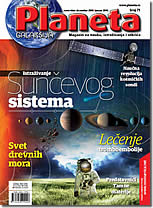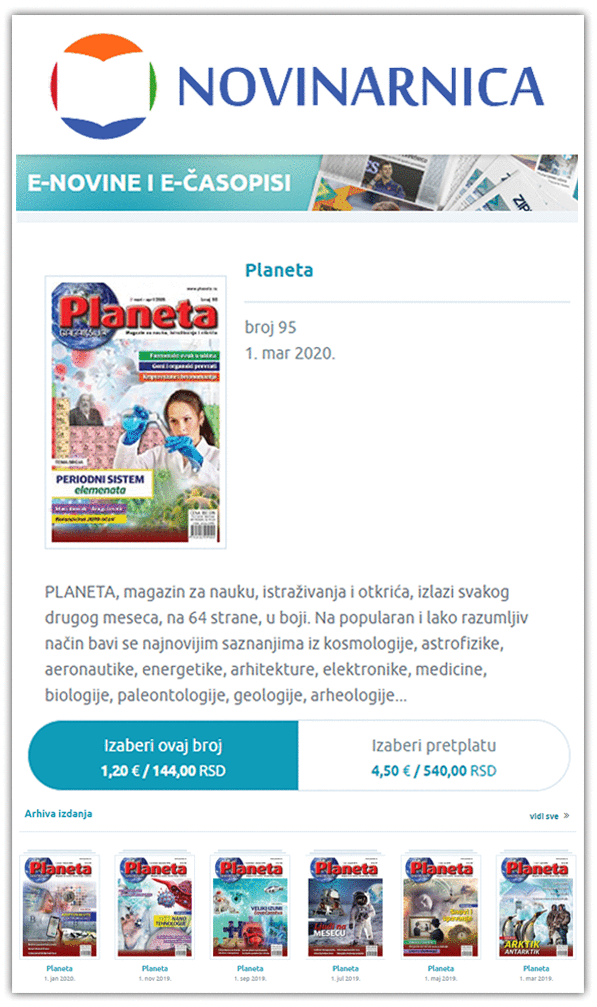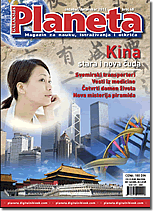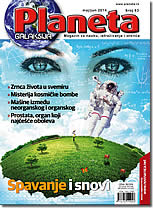| » BROJ 71 |
 |
Godina XII
Nov. 2015 - Jan. 2016
|
|
| » Glavni naslovi |
SUMMARY
Summary
The Topic of this Issue
Cosmos
Research of the Solar System |
|
 |
How comes there is life in cosmos? How ere the planets formed? How come there is water in some parts of our constellation? How comes there is air on Earth? How is it possible to travel to other planets?
Over recent decades there has been an increasing human effort made to study the Solar system. There is an increasing number of telescopes and space shops which flew or are flying as we speak to the most remote parts of the Solar system. Two space ships are already near the limits of the interstellar space, other two recently flew by the most remote planets, first detailed testing has been done of the ice and the dark space of Cosmos. Science is coming up with unexpected findings, experts are thinking of how to construct more sophisticated and faster ships, although the existing ones are flying at unimaginable speeds of about fifty thousand kilometers per hour! The Earth is but a tiny shiny dot destined to preserve life and its inhabitants are destined to research the Cosmos. Here are just a few titles of issues covered: the proportions of the Solar system, the reducing planet, the Moon on the Earth, new astronautics, missions bordering on SF, the gas giant without a solid lake, etc. |
Nanotechnology
With the billionth part of a meter |
|
 |
There has been much debate regarding the future development and implications of nanotechnology. The huge potential offered by this discipline in developing new materials and devices with a broad scope of applications, such as in medicine, electronic industry, biomaterials, and energy generation. On the other hand, there are numerous challenges related to the introduction of this new technology in daily life. Especially in terms of impact on the living environment and effects on the global economy, accompanied by many beliefs that nanotechnology would be bringing along the end of the world. This has caused concern globally and raised the issue as to whether there is a need for a special law regulating nanotechnology?
Nanotechnology is a science dealing with controlling matter at atomic and molecular level, manipulating structures of the order of magnitude of dozens to a hundred nanometers and involves the development of materials and devices of such size. It is a very diverse science ranging from conventional to completely innovative approaches based on self-assembly of molecules, design of innovative materials of nanometric dimensions and research into whether it is possible to control matter at atomic level.
A nanometer is a billionth part of a meter, meaning that if we were to assume that 1nm equals 1 m, one marble would be the size of our planet. |
Climate
The French-Serbian month of science |
|
 |
Science has shown that also in the past the Earth warmed up under the influence of the greenhouse effect, but that happened some 60 million years ago (during the Eocene epoch) and about three million year ago (during the Pliocene). In more recent history, compared to the past 1500 years, the warming up of our planet during the past three decades has been unprecedented, accompanied by increasing natural disasters – heat waves, hurricanes, flooding.
This year's French-Serbian month of culture, under the title of “Environmental Challenges: How about Acclimatizing?”, held by the French Institute in Serbia from 17 September to 24 October was dedicated to the topic of global warming, the increasingly serious threat to human life on the Earth. France will be presiding over the forthcoming World Climate Conference to be held in December (COP 21) which is expected to achieve an international agreement to enable the achievement of the ambitious but achievable goal – limiting further global warming to lees than 2°C. |
Medicine
Pulmonary thromboembolism |
|
 |
Clogging of pulmonary blood vessels due to clots may have asymptomatic forms detected by coincidence and causing some of the worst types of embolism leading to sudden death. That is why this condition, which can practically affect anyone, should be kept in mind in order to be detected, diagnosed and treated, warns dr Vojkan Čvorović, cardiologist of Bel Medic hospital.
Pulmonary embolism is relatively common and can be life threatening, while timely detection and treatment significantly reduce the fatal consequences of this often urgent condition. Generally, pulmonary embolism is an obstruction of the flow in the pulmonary artery and its branches caused by embolus – biological matter, a foreign body or even air – circulating and reaching the lungs from distant parts of the body. In terms of global incidence, pulmonary embolism has a very third high among cardiovascular diseases, with annual incidence of 100 – 200 new cases per 100,000 people.
|
Architecture Museum as a work of art |
|
 |
Modern museum buildings prove the saying that “Architecture is the true art”. The content of art and natural collections follows this concept and adds to it making visible landmarks in the cities where the museums are located. Among the most striking examples of this are the Royal Ontario Museum (Canada), the National Museum of Art Osaka (Japan) and the Aron Art Museum of Ohio (USA).
The art of museum architecture through unusual and attractive structures has been successful in attracting the audience. There are many such examples, these three barely being among the most extraordinary ones. |
Paleontology
Corals, colorful worlds of ancient seas |
|
 |
"Coral" is a terms used to denote marine invertebrates of the Anthozoa class (Gr. anthos - flower), consisting of a lesser or greater number of tiny coral creatures – polyps – living in colonies having at their tops the mouth opening surrounded by tentacles used to capture food. They live solitary lives in colonies and can take different shapes resembling trees, bushes, fans or blossoms of diverse bright colors.
Once hundreds and thousands of polyps build skeletons a coral reef is formed, representing the most beautiful parts of the marine world resembling great colorful gardens. At the same time they are the biggest solid structures in the world built of living organisms, located under the surface of oceans, predominantly in tropical regions. Under favorable conditions they can grow to huge scales, such as the current Australian coral reef. |
Archaeology
Prehistoric villains |
|
 |
At a distance of 15 km from Frankfurt am Mein, in the Germans federal state of Hessen, is the municipality Shenek, and in it the village of Kilianstaten, as of recently a sensational and somewhat bizarre archaeological discovery: a mass grave has been found there dating back seven millennia. Detailed research has been conducted of 26 corpses, including children, victims of violence.
The most striking traces of violence were identified on leg calves. About one half of victims show traces of intentions to crush this part of the leg. There can be two possible reasons behind this: firstly, this was done to prevent the victims from fleeing; second, this was done as a warning to demonstrate the destiny awaiting those who have survived the terror of these prehistoric villains. There is also a theory that destruction of leg calvs resulted from a belief that it would prevent the ghosts of victims from haunting the perpetrators. |
Science as life
The Book of Legal Rules – the biggest Serbian book |
|
 |
The history of the Serbs, especially of the Middle Ages, and of other Christian Orthodox peoples of the Byzantine commonwealth, would be incomplete without the study of theology and history of the Christian church, especially the Medieval ones. There are very few historians with thorough knowledge in this area. One of the unparalleled contemporary experts is Miodrag M. Petrović, Ph.D. (1936), a retired scientific associate of the Institute of History. Petrović is a historian canonologist, expert in the history of the Church and the old Serbian law. He is the author of the critical publication The Book of Legal Rules of Saint Sava in the Serbian-Slavic and Serbian language, a church-civic compendium from the first decades of the XIII century.
His patient work first resulted in the publication of the Ilovički re-written Book of Legal Rules, also known as the Nomocanons of Saint Sava , the most ancient of the 11 preserved copies of the Serbian review, dating from 1262, as the basic text, and the first part of the Book of Legal Rules in the Serbian-Slavic and Serbian language . Work is currently underway translating the last chapters of the second volume which covers the civil law.
|
Kompletni tekstove sa slikama i prilozima potražite u magazinu
"PLANETA" - štampano izdanje ili u ON LINE prodaji Elektronskog izdanja
"Novinarnica"
|
|
|
| » Pratite nas |
 |
 |
|
» Prijatelji Planete |
| » ON LINE PRODAJA |
|

6 digitalnih izdanja:
4,58 EUR/540,00 RSD
Uštedite čitajući digitalna izdanja 50%
Samo ovo izdanje:
1,22 EUR/144,00 RSD
Uštedite čitajući digitalno izdanje 20%
www.novinarnica.net
Čitajte na kompjuteru, tabletu ili mobilnom telefonu

|
| » PRELISTAJTE |
NOVINARNICA predlaže
Prelistajte besplatno
primerke

Planeta Br 48

Planeta Br 63
|
| » BROJ 71 naslovna |
 |
Godina XII
Nov. 2015 - Jan. 2016
|
|
|

